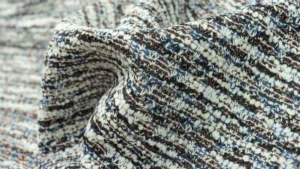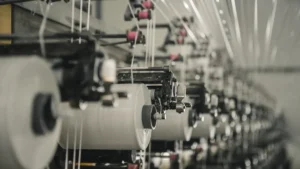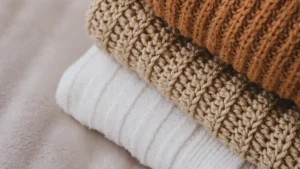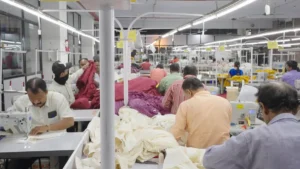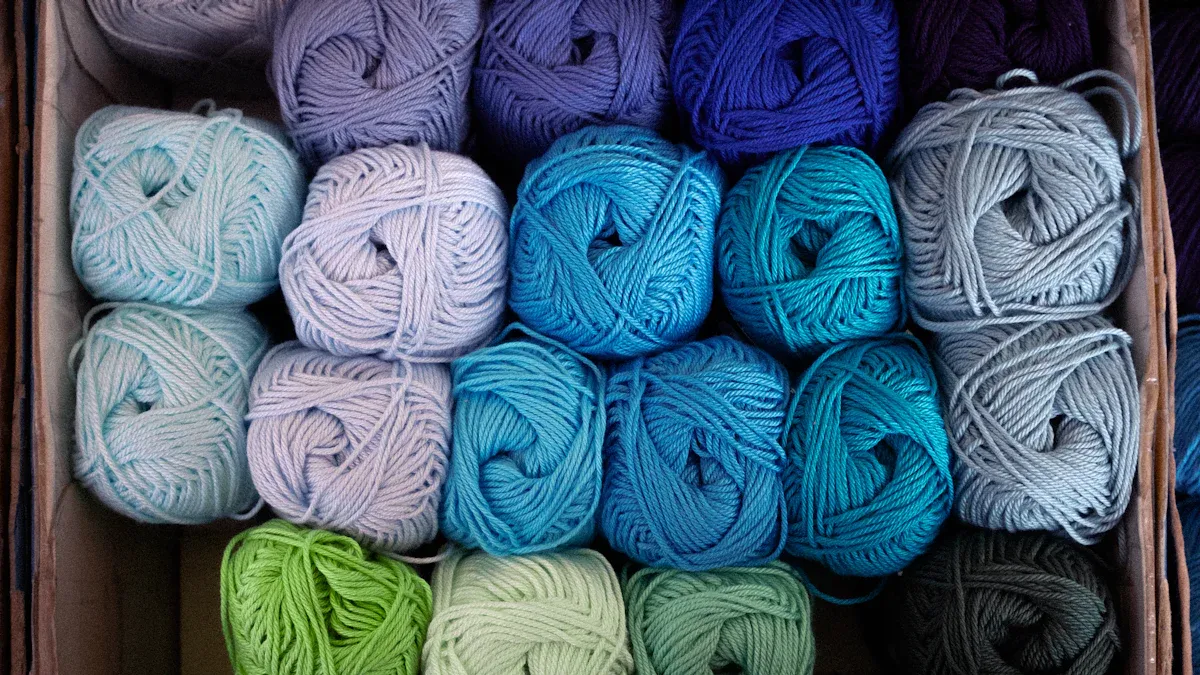
Knitwear construction needs close attention to seam types and finishing. The seam you pick affects how long the garment lasts. Studies show that using the right stitch class and seam type makes knitwear stronger. This can help the garment last longer. Areas that get a lot of stress need reinforced seams. These seams stop tearing and help keep the shape. Good seam quality also changes how the knitwear looks and feels. It makes sure each piece can handle being worn every day.
Key Takeaways
Picking the right seam type is very important for knitwear. It helps make the garment strong, stretchy, and comfy. – Overlocked and serged seams keep the edges safe. They let the fabric stretch without tearing. – Flat seams help stop rubbing and extra thickness. This makes activewear feel better to wear. – Using the right needles and stretch stitches is important. It helps stop skipped stitches and seam problems. – Finishing seams neatly with serging, zigzag stitches, or pressing is helpful. It makes the garment last longer and look nicer.
Why Seams Matter in Knitwear Construction
Structure and Durability
Seams are very important in knitwear. They hold the fabric pieces together. This is what keeps a sweater in one piece. In knits, picking the right seam is extra important. Knit fabric can stretch and move a lot. Overlocked seams are often used for knits. These seams sew, cut, and cover the edges at the same time. This stops the fabric from fraying. It also lets the seam stretch with the fabric. Chainstitch and overedge stitches help the seam stretch more. This keeps the seam from breaking when you pull on the garment. Flat seams are used in activewear. They lay flat and do not rub the skin.
Seams help the garment keep its shape.
Overlocked seams make the garment last longer and stop fraying.
Flat seams make the garment comfy and steady in places that move a lot.
Stretch and Comfort
The seam type changes how a sweater feels and fits. The way seams and stitches are made controls stretch and comfort. Strong seams are needed at arm joints. This helps the sweater stay comfy when you move. How close the stitches are and how the fabric is made also matter. These things change how much the seam can stretch and how strong it is.
Effect on Stretch | Effect on Comfort | Additional Notes | |
|---|---|---|---|
Linked Seams (Fully-fashioned) | Medium stretch | Less rubbing at the neck; can feel rough | |
Seamless Knitwear | Very stretchy | Feels soft; does not bother the skin | |
Cut and Sew | Depends on fabric | Can rub the skin; not always comfy |
Seams help stop the fabric from slipping. They keep the sweater steady, even when you move a lot. How the seam is made matters more for comfort than the fabric itself.
Aesthetics and Professional Finish
A neat finish makes knitwear look special. Serger seams give knits a smooth, strong edge. These seams bounce back well after stretching. Double stitched seams are good for thick knits. They look tidy and do not add extra thickness. Foldover elastic seams look nice and feel soft. They are used a lot in activewear. Fancy finishes like bias binding are not common in knits. But they show great skill when used.
Serger seams make the garment look neat and pro.
Double stitched seams are best for thick knits and look simple.
Foldover elastic seams add style and feel good.
Picking the right seam and finish makes the sweater look nice and feel good to wear.
Types of Seams in Knitwear
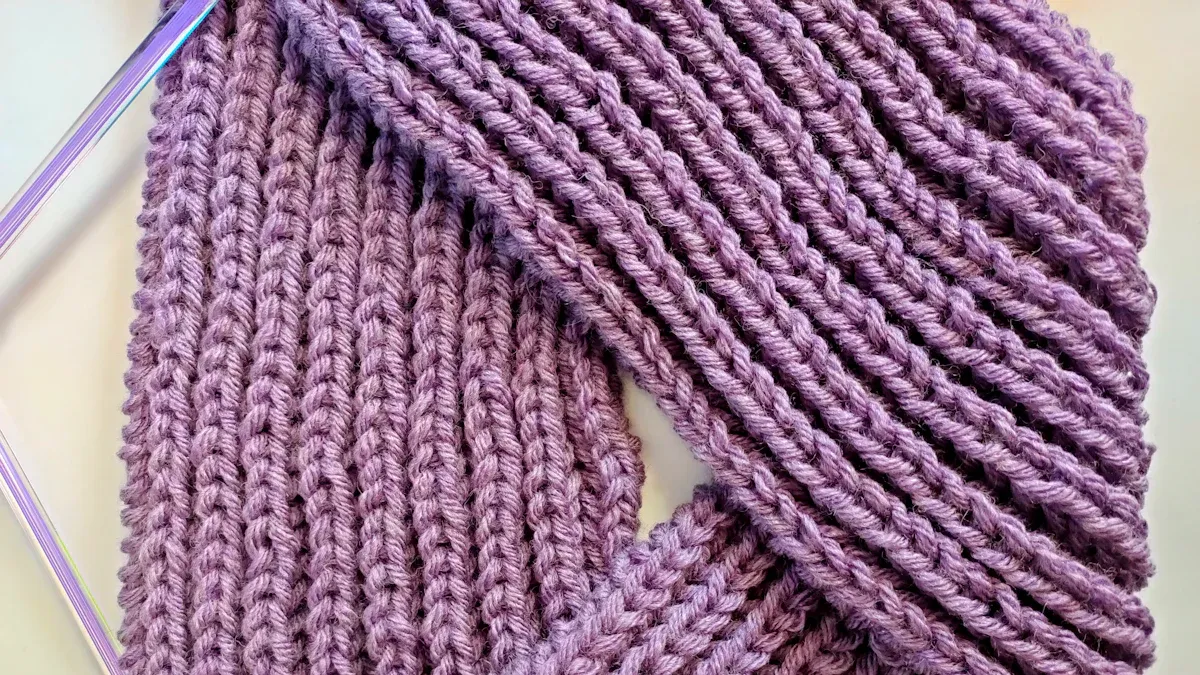
Understanding the types of seams used in knitwear construction helps professionals choose the right method for each project. Each seam type offers unique benefits for stretch, durability, or appearance. The following sections explain the most common types of seams in knits, their characteristics, and their best applications.
Plain Seam
A plain seam is the most basic way to join two pieces of fabric. In this method, the right sides of the fabric face each other, and a single line of stitching holds them together. This seam is common in many garments, but it has some limits in knits.
Best Uses:
Light-to-medium weight knits
Areas with low stress
Projects where a simple join is needed
Pros:
Simple and quick to sew
Helps fabric lie flat
Works well for woven fabrics
Cons:
Exposes raw edges, which can fray in knits
Needs extra finishing, such as zigzag stitch or serger, to prevent fraying
Less stretch than other types of seams
Note: Overlock seams are often preferred for knits because they provide more stretch and protect the edges better than a plain seam.
Serged Seam (3-Thread, 4-Thread)
A serged seam uses a serger machine to sew, trim, and finish the edge in one step. This seam is very popular in commercial knitwear production.
Seam Type | Thread Configuration | Characteristics | Preferred Use for Knits |
|---|---|---|---|
1 needle, 2 loopers | Less bulky, flexible seam | Light to medium knits needing stretch and less bulk | |
4-thread serged | 2 needles, 2 loopers | Wider, stronger, more durable | Areas needing strength and durability; seaming and finishing in one pass |
Best Uses:
Everyday knit garments
High-stress areas
Projects needing both stretch and durability
Pros:
Strong and neat seam
Prevents fraying
Stretches with the fabric
Finishes edges in one step
Cons:
Needs a serger machine
Can be bulky in very fine knits
Tip: Use a 3-thread serged seam for flexibility and less bulk. Choose a 4-thread serged seam for extra strength in areas like side seams or underarms.
French Seam
A french seam encloses the raw edges inside the seam, making it look clean on both sides. This seam is sewn twice: first with wrong sides together, then with right sides together.
Best Uses:
Lightweight or sheer knits
Garments worn close to the skin
Projects needing a polished finish
Pros:
Fully encloses raw edges
Reduces bulk
Lies flat and feels smooth
Looks professional inside and out
Cons:
Takes more time to sew
Not ideal for thick or bulky knits
Needs careful trimming for best results
French seams work well for delicate knits that fray easily. They add durability and a neat look, especially in fine sweaters or lingerie.
Flat-Felled Seam
A flat-felled seam is a closed seam that hides all raw edges and creates a flat, strong join. This seam uses two lines of stitching and folds the fabric edges inside.
Best Uses:
High-stress areas
Sportswear and jeans
Projects needing a durable, flat seam
Pros:
Very strong and durable
Closed seam protects edges
Lies flat, reducing bulk
Looks neat on both sides
Cons:
More steps than a plain seam
Can be bulky in thick knits
Needs careful folding and stitching
Seam Type | Defining Characteristics | Stitch Types Used | Typical Applications |
|---|---|---|---|
Flat-Felled Seam | Strong, durable closed seam covering raw edges; flat crease; often two stitching operations | 401 chainstitch (commonly) | Pants, denim, jeans, sportswear |
Flat-felled seams are ideal for garments that need strength and a smooth finish, such as activewear or outerwear.
Lapped Seam
A lapped seam overlaps one fabric edge over another and stitches them together. This seam is flat and strong, making it useful for certain types of knits.
Best Uses:
Fabrics that do not fray, like felt or leather
Decorative seams
Straight or slightly curved edges
Pros:
Flat, low-bulk seam
Strong and durable
Can be decorative with contrast thread
Good for high-stress areas
Cons:
Not suitable for all knits
Needs precise alignment
May not stretch as much as other seams
Lapped seams often appear in leather jackets, upholstery, or bags made from knits that resist fraying.
Mattress Stitch
The mattress stitch is a hand-sewing technique used to join knitted pieces side by side. This seam is almost invisible and keeps the fabric flat.
Best Uses:
Sweater side seams
Sleeves
Projects needing a seamless look
Pros:
Nearly invisible join
Maintains fabric stretch
Adds structure and support
Easy to adjust for perfect alignment
Cons:
Takes time to sew by hand
Needs careful tension control
Not as strong as some machine seams
The mattress stitch gives hand-knit garments a polished, professional finish. It helps sweaters keep their shape and prevents sagging.
Grafting (Kitchener Stitch)
Grafting, also called Kitchener stitch, joins two sets of live stitches to create a seamless join. This method is common for closing toes of socks or joining sweater shoulders.
Steps for Grafting (Kitchener Stitch):
Place half the stitches on a front needle and half on a back needle.
Thread a tapestry needle with yarn.
Insert the needle purlwise into the first stitch on the front needle.
Insert the needle knitwise into the first stitch on the back needle.
Repeat the sequence, slipping stitches off as you go, until all stitches are joined.
Adjust tension to match the rest of the fabric.
Best Uses:
Sock toes
Shoulder seams
Any area needing a seamless, flexible join
Pros:
Seamless, invisible join
Maintains fabric stretch
Feels smooth against the skin
Cons:
Requires practice to master
Needs careful tension control
Best for live stitches, not finished edges
Grafting creates a closed seam that looks and feels like the rest of the knit fabric, perfect for areas needing comfort and flexibility.
Backstitch and Blanket Stitch
Backstitch is a strong hand-sewn seam, while blanket stitch finishes edges and joins pieces with a decorative touch.
Best Uses:
High-stress areas (backstitch)
Decorative edges (blanket stitch)
Projects needing extra strength
Pros:
Backstitch creates a strong, durable seam
Blanket stitch adds a decorative finish
Both can be used for hand-seaming
Cons:
Backstitch has limited stretch
Blanket stitch may not be as strong
Both take more time than machine seams
Feature | Backstitch | Mattress Stitch |
|---|---|---|
Seam Strength | Strong, durable seam for stress areas | Nearly invisible, flat seam for flexible joins |
Appearance | Visible seam line, worked from wrong side | Seamless look, worked from right side |
Flexibility | Limited stretch, can feel stiff | Maintains fabric elasticity |
Best Use | Shoulder seams, high-stress joins | Side seams, sleeves, neat joins |
Backstitch works best for shoulder seams or places needing a strong and neat seam. Blanket stitch is ideal for finishing open seam edges or adding a decorative touch.
Crochet Seam
A crochet seam, such as the whipstitch, uses a crochet hook or needle to join pieces. This seam is easy to adjust and works well for many knitwear projects.
Best Uses:
Sweaters
Projects needing a flexible join
Areas where a decorative seam is desired
Pros:
Easy to sew and adjust
Can match yarn for a seamless look
Allows for blocking before or after seaming
Avoids bulk if tension is controlled
Cons:
May show if yarn does not match
Needs practice for even tension
Not as strong as some machine seams
Crochet seams offer flexibility and a neat finish, making them a good choice for assembling sweaters and other knit garments.
Sewing with Knits: Key Techniques
Essential Tools and Needles
You need special tools to sew knits well. Ballpoint or stretch needles are best. They move the fibers aside, not poke holes. This stops skipped stitches and snags. Use size 75/11 needles for light knits. Use size 80/12 or 90/14 for medium knits. Twin needles make neat hems with two lines. Use knit interfacing or twill tape for strong shoulder seams. Fusible hem tape keeps hems flat. Set your machine to a narrow zigzag or stretch stitch. This lets the seam move with the knit. A walking foot helps feed fabric evenly. It stops the fabric from stretching or getting twisted. These tips help you sew knits smoothly and make strong seams.
Tip: Pick the right needle for your fabric. This keeps seams strong and stops damage.
Choosing the Right Stitch
Picking the right stitch is very important for knits. A narrow zigzag or stretch stitch lets seams stretch. This stops seams from breaking. Use a straight stitch where stretch is not needed. Stitch type and how close the stitches are matter. More stitches make seams stronger and last longer. Double needle lock stitches and chain stitches are good for strong spots. Change stitch length and tension to make seams work better.
Managing Stretch and Recovery
Knits can stretch in two or four ways. Knowing this helps you sew them better. Stretch or jersey needles stop skipped stitches. A walking foot or knit foot feeds fabric evenly. Wash-away tape helps with slippery knits. Lower the presser foot pressure and use longer stitches. This keeps seams from looking wavy. Wash fabric before sewing to stop shrinking later. Patterns for knits fit better because they allow for stretch. Press with low heat and a cloth to protect the fabric. These tips help knits keep their shape and bounce back.
Use fusible interfacing to make buttonholes strong.
Cut fabric carefully so it does not stretch out.
Let fabric rest before cutting to get the right size.
Cut-and-Sew vs. Fully Fashioned Methods
Aspect | Cut-and-Sew Knitwear | Fully Fashioned Knitwear |
|---|---|---|
Production Process | Uses fabric that is already made and cut into pieces, then sewn together. | Each piece is knitted into the right shape, so there is less waste. |
Design Flexibility | You can change the panels after cutting, so it is flexible. | You can make detailed designs right in the knitting. |
Cost and Efficiency | Costs less at first and works for big or small batches. | Costs more at first, but is good for big runs or custom pieces. |
Quality and Finish | Seams show and finishes can change; may not look as fancy. | Looks seamless and fits well, with a high-quality finish. |
Cut-and-sew uses fabric that is already made, so it is flexible and saves money. Fully fashioned knits shape each part while knitting, so there are no seams and it looks smooth. Each way is good for different needs, from making lots of clothes to making fancy ones. Knowing these ways helps people pick the best one for their project.
Seam Finishing Techniques for Knits
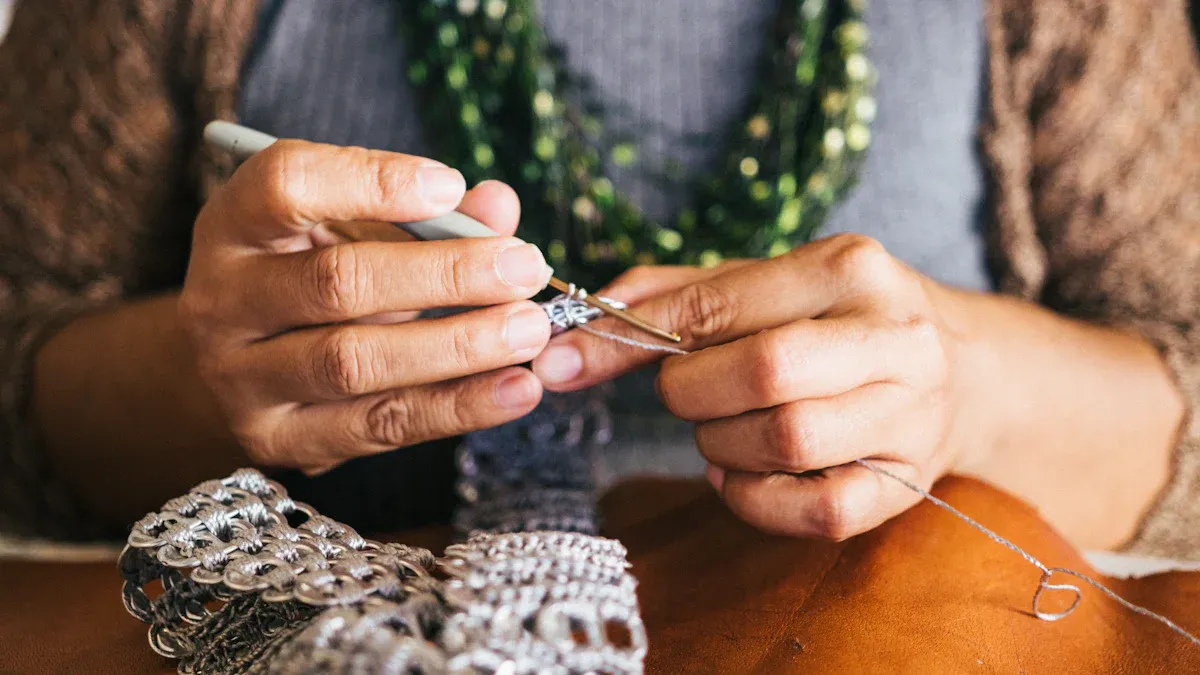
Serging and Overlocking
Serging and overlocking are great ways to finish seams in knits. A serger cuts, sews, and covers the seam edge all at once. This makes a strong seam that can stretch and does not fray.
Overlock stitches make seams very stretchy and neat.
Sergers help keep stretchy fabric from getting pulled out of shape.
Factories use sergers because they make tough, bendy seams.
Serged seams get trimmed as you sew, so they look neat.
A serger wraps thread around the raw edge, so the inside looks tidy. You can change the feed to keep seams flat, even on hard fabrics.
Zigzag Stitch
The zigzag stitch is an easy way to finish seams on knits. This stitch can stretch with the fabric, so seams do not break when you move. Many people use zigzag stitches for hems, necks, and seams in underwear or swimsuits.
Zigzag stitch is good for seams and hems that must stretch.
It works for both making and finishing seams.
Beginners think zigzag stitches are easier than using two needles.
Knit fabric does not usually come apart, so zigzag is often enough. Pressing seams after sewing makes them look better and helps them stay flat.
Bias Binding
Bias binding covers raw seam edges with a strip of fabric cut on the bias. This finish makes seams stronger and can look nice. It works best for light or medium fabrics. Bias binding gives a clean look and lets you pick fun colors or patterns. But it takes more time and skill than other finishes for knits. You must be careful so the binding does not stretch out.
Pinking Shears
Pinking shears cut fabric edges in a zigzag shape. This helps stop fraying in woven fabric but is only okay for knits.
Method | Best For | Durability | Visual Impact |
|---|---|---|---|
Pinking Shears | Lightweight fabrics | Moderate | Casual |
Serging | All types, especially knits | Excellent | Professional |
Zigzag Stitch | Stretchy and woven fabrics | High | Clean |
For knits, serging and zigzag stitches work better than pinking shears.
Blocking and Pressing
Blocking and pressing are important for finishing seams. Blocking shapes knit pieces to the right size and helps seams stay flat. Pressing with steam and a cloth takes out wrinkles and sets the stitches. These steps make seams look better and help the garment look neat. Factories use steam blocking to make sure knits look nice and even. Blocking and pressing make sewing easier and help the finished piece keep its shape.
Choosing the Right Seam and Finish
Matching Seam to Fabric and Garment
Picking the right seam for each fabric and garment is important. This helps make clothes strong and comfy. Different fabrics need different seams. Light knits often need seams that hide raw edges, like a French seam. This stops fraying and makes the inside smooth. Heavy knits need strong seams that can stretch, like an overlocked seam. These seams help the garment handle pulling and moving. What the garment is for also matters. Sportswear works best with flat seams. These seams stop rubbing and feel soft. Formal clothes may use seams that are hidden for a neat look. The table below shows how to match seam types to fabric and garment needs:
Criteria | Knit Fabrics Requirements | Garment Style Considerations | Seam Types & Stitching Details |
|---|---|---|---|
Fabric Type | Needs seams with stretch to prevent breakage | Sportswear: flat seams; Formal: enclosed seams | Overlocked, flat, or plain seams |
Fabric Weight & Behavior | Heavy knits: durable seams; Light knits: less bulk | Light fabrics: French seams; Heavy: flat-felled | Stitch density affects strength and flexibility |
Garment Function & Stress | High-stress areas: reinforced seams | Function influences seam choice | Reinforced or decorative seams as needed |
Seam Appearance | Visible or hidden based on design | Formal: hidden seams; Sports: flat seams | Flat-felled, French, or decorative seams |
Tip: Always check how much the fabric stretches and how heavy it is before picking a seam. This keeps the garment in shape and comfy.
Balancing Durability and Appearance
Knitwear makers need to make seams strong but also nice to look at. Using threads that are both strong and stretchy, like corespun or bonded nylon, helps seams last and look tidy. Ballpoint needles keep the fabric safe from holes and missed stitches. Changing thread size and stitch tension helps stop puckering and keeps seams flat. Flat-felled seams hide the raw edges and make seams stronger. Simple edge seams are good for places that do not get pulled a lot. Makers pick seam types that fit the fabric and how the garment will be used. This way, the clothes last longer and look professional.
Flat seams are best for activewear because they do not rub or feel bulky.
Reinforced seams are good for spots that get pulled a lot so they last longer.
Pick seam types that hide thread so the garment wears better.
Common Mistakes to Avoid
There are mistakes that can make seams weak or the garment less comfy. Using the wrong seam for the fabric can make seams break or feel bad. Not changing stitch length or tension can make seams pucker or look twisted. Forgetting to make seams stronger in stress spots can make seams break early. Not writing seam details in the tech pack can cause mistakes when making the garment.
Common pitfalls include:
Using thick seams on light fabrics, which makes them heavy.
Not leaving enough seam allowance, which makes joins weak.
Not finishing seams, which can cause fraying and make the garment wear out faster.
Note: Always test seam samples on the real fabric before making lots of garments. This helps make sure the fit, comfort, and strength are just right.
Knitwear construction needs the right seams, sewing, and finishing. Experts say there are some good steps to follow for pro results:
Pick strong seams like flat-felled or French seams to make clothes last.
Use stretch stitches like zigzag or overlock for fabrics that move.
Finish edges with double fold hems or serged hems to help clothes last longer.
Check fabric quality and seam allowances before you start sewing.
Make high-stress spots stronger with double-stitch or multistitch zigzag.
Practice new seam methods on scrap fabric first.
Look for more guides to get better at knitwear construction.
Anyone can make their projects better by using these tips and working for a pro finish.
FAQ
What seam type works best for stretchy knit fabrics?
A serged seam is great for stretchy knits. It uses more than one thread, so the fabric can move and not break. Most people use serged seams for sports clothes and everyday knits.
How can someone prevent seams from puckering on knits?
Lower the presser foot pressure to help the fabric move right. A walking foot helps feed the fabric evenly. Use a stretch stitch or zigzag stitch to stop puckering. Try sewing on scrap fabric first to see what works best.
Is it necessary to finish the edges of knit fabrics?
Most knits do not fray like woven fabrics. But finishing the edges with a serger or zigzag stitch makes them look neat and strong. Pro clothes always have finished edges to last longer.
Can hand-sewn seams be as strong as machine-sewn seams?
Hand-sewn seams like backstitch are strong for small spots. Machine-sewn seams are stronger and more even for most clothes. People use both ways for different parts of a project.



